Psoriasis Types:-
Plaque Psoriasis
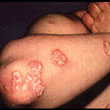 Plaque psoriasis
Plaque psoriasis is the most common type of
psoriasis. About 80% of people who develop psoriasis have
plaque psoriasis,
which appears as patches of raised, reddish skin covered by
silvery-white scale. These patches, or plaques, frequently form on the
elbows, knees, lower back,and scalp. However, the plaques can occur
anywhere on the body.Skin discomfort. The skin is dry and may be
painful. Skin can itch, burn, bleed, and crack. In severe cases, the
discomfort can make it difficult to sleep and focus on everyday
activities.
Guttate Psoriasis
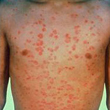
This type of
psoriasis
presents as small red scaly dots (instead of thick plaques), which look
like drops of water sprinkled over the body.About 10% of people who get
psoriasis develop
guttate psoriasis, making this the second most common type.
Guttate psoriasis most frequently develops in children and young adults.
Pustular Psoriasis
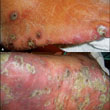
It appears as raised bumps that are filled with non-infectious pus. This type of
psoriasis affects less than 10% of patients.The skin under and surrounding
pustules is
red and tender.The
palms of the hands, soles of the feet, fingers and nails are most
affected The affected areas become red and scaly, cracks may form and
these are often painful. It has been thought to be a pustular variant of
psoriasis.
Inverse Psoriasis
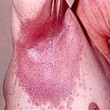 Inverse psoriasis
Inverse psoriasis not common,
inverse psoriasis also is called "skin-fold. This type of psoriasis can be severe and in capacitating
Inverse psoriasis is found in the armpits, groin, under the breasts, and in other
skin-folds.
Erythrodermic Psoriasis
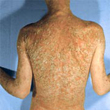 Erythrodermic psoriasis
Erythrodermic psoriasis
is a particularly inflammatory form of psoriasis that often affects
most of the body surface.It is characterized by periodic, widespread,
fiery redness of the skin. The erythema (reddening) and exfoliation
(shedding) of the skin are often accompanied by severe itching and pain.
Psoriatic Arthritis
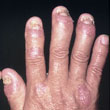
Several years after
psoriasis has broken out, the patient may be affected by
psoriatic arthritis.This
is an inflammatory, chronic arthritis with variable degree of joint
manifestations.It involves peripheral joints (the hips, shoulders, hands
and feet) in 70% of cases.About 10 percent to 30 percent of people with
psoriasis also develop
psoriatic arthritis,
which causes pain, stiffness and swelling in and around the joints.but
for most people it appears between the ages of 30 and 50.
Psoriatic arthritis seems to affect men at a slightly higher percentage than women.
Scalp Psoriasis
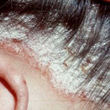 Scalp psoriasis
Scalp psoriasis is very common.When
psoriasis occurs on the scalp,
psoriasis often causes
silvery-white scale,
which may be misdiagnosed as dandruff.skin cells grow too quickly on
the scalp and cause red lesions covered with scale to appear.
Scalp psoriasis,
even though often adequately camouflaged by the hair.Many patients
experience severe itching and a feeling of tightness and some report
soreness.
Nail Psoriasis
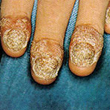
It produces a variety of
changes in the appearance of finger and toe nails. These changes include
discolouring under the
nail plate,
pitting of the nails,
lines going across the nails, thickening of the skin under the nail,
and the loosening ) and crumbling of the nail.Nail changes occur in
25-50% of people who have psoriasis, they are more common in people who
also have
psoriatic arthritis.